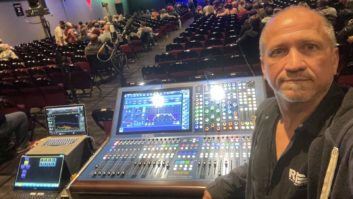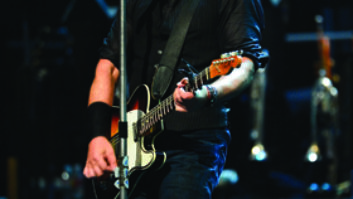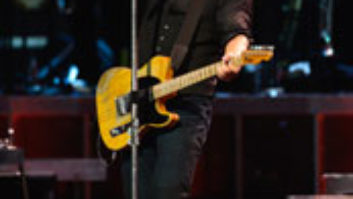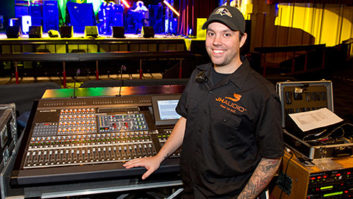Bruce Springsteen & the E Street Band Hit the Road AgainBruce Springsteen worked with the E Street Band for close to 20 years before he dissolved the unit in the late ’80s to explore other musical settings for his songs. The new group that recorded and toured with Springsteen in the early ’90s never achieved the same public recognition as the E Street Band and was, some would say predictably, short-lived. Next, as if to further distance himself from the E Street days, Springsteen embarked on solo acoustic tours that focused on the material from his most recent album-length recording, the spare The Ghost of Tom Joad.
However, late last year, word came of a reunion tour by Springsteen and a re-formed E Street Band that would feature not only original guitarist Steven Van Zandt (who had left to front his own band just as Springsteen was reaching his greatest popularity) but also his replacement, Nils Lofgren. Original members drummer Max Weinberg, bassist Garry Tallent, keyboardists Roy Bittan and Danny Federici and Bruce’s main visual foil, Clarence “Big Man” Clemons on saxophone, would all return, and, with the addition of Springsteen’s wife Patti Scialfa on vocals and guitar, the reconstituted E Street Band would consist of eight members.
Springsteen fever made show tickets the hottest in the country. Following 36 European tour dates, the initial five U.S. dates at the 20,000-seat Continental Airlines Arena in East Rutherford, N.J., sold out within two hours. Another five shows were immediately added and then another five, all of which sold out; the final total of 15 Jersey shows would draw approximately 300,000 people. Dates in Boston, Washington, D.C., Detroit, Philadelphia and Chicago followed a similar multiple show/sell-out pattern. (West Coast dates had not yet gone on sale at press time.)
Mix attended an East Rutherford show on a bright day in August. The Continental Arena’s parking lot was filled with minivans, lawn chairs, charcoal grills and boom boxes blasting “Jungleland” and other old Springsteen favorites. A wretchedly weak and off-key Springsteen imitator yelped a mangled version of “Born to Run” from a boardwalk-style attraction that had been set up, mercifully, on a distant edge of the lot. Inside, the mostly older crowd seemed psyched to relive the most memorable and resonant pop cultural experiences of their youth. Much of the audience was made up of couples about the same age as the star; many had brought excited pre-teen and teenaged children.
After a long delay, the E Street Band finally took the stage one by one, with Springsteen emerging last. The first part of the show featured straight-ahead, no-nonsense renditions of one favorite after another, including “Badlands” and “Two Hearts,” before Springsteen moved into his special brand of engagingly dopey showbiz shtick. For example, during the intro to “Tenth Avenue Freeze-Out,” Springsteen climbed atop Bittan’s grand piano and urged the crowd to belt out the song’s introductory notes with increasing fervor. Over and over, Springsteen good-naturedly cajoled the audience as the band vamped, displaying exaggerated disappointment with the crowd’s reaction until they had reached a sufficient level of volume and enthusiasm.
Mid-song, Springsteen segued into a Talking Heads-influenced version of “Take Me to the River” and then went into a story about how he’d long ago sought advice from a gypsy fortune teller to help him conquer his fear of crossing an unnamed river. His problem was, the gypsy dramatically revealed as she loomed over her crystal ball, that he was trying to make this epic journey alone.
Springsteen used the soothsayer’s prescription, outlining the specific kinds of help he needed to complete the journey (love from Scialfa, brotherhood from Clemons, etc.) as an opportunity to lovingly introduce each band member, finally going back into “Tenth Avenue.” As the singer joyously belted the concluding lyrics-“when the change was made uptown and the big man joined the band”-Clemons wailed a variation on his basic trademark sax riff, and the crowd erupted into a rousing, hand-waving ovation.
DUAL FOH CONSOLESThe man behind the knobs at the FOH position during all this excitement was John Kerns of Audio Analysts Inc. in Colorado Springs, Colo. Audio Analysts also provides sound reinforcement for neo-country knockout Shania Twain (both Springsteen and Twain are managed by Jon Landau), and the large FOH mix area contained equipment cases stenciled “Shania Twain,” indicating that the gear for both acts is essentially the same. “We find what works and then use it,” Kerns acknowledged.
However, in spite of the similar sound systems, the two acts are worlds apart. “Shania’s show is note-for-note, must-sound-like-the-record every time,” Kerns noted. “Bruce’s is more like just a bunch of guys grabbing guitars and hopping on stage and playing.”
To accommodate the 65 inputs from the stage, Kerns was using two consoles, Midas XL-3 and XL-4 models, with the smaller XL-3 console set at 90degrees to the larger XL-4 (the “A” board), which faced the stage. “Other than the kick, hi-hat and snare, I’ve got the drum kit on the XL-3,” explained Kerns. “I return the drum sub-mix to the main board on a stereo module, the same with the keyboards, so that the faders I need are right in front of me, on the A board.”
Unlike many rockers who play the same exact set night after night, Springsteen always varies his show, sometimes wildly, so Kerns has bypassed the XL-4’s VCA moving fader automation. “We have significant set changes, sometimes as many as half-dozen or more, every night,” Kerns noted. “It would take me too long to scroll through and find the automated cue for a song that has suddenly been added to the set and hit ‘go,’ so I mix manually. That works for me, although sometimes I get caught flat-footed!”
HIGH DEFINITION STEREO88 Audio Analysts Aalto High Definition speaker cabinets were arranged in nine zones to provide stereo coverage throughout the house. Because almost every seat is being sold for the U.S. arena dates, including those behind the stage, the P.A. was set up in a 360degrees configuration. In fact, Springsteen and the band gave special attention to those seated in back, at one point walking up ramps on the simple stage and playing a few feet from the first row of the behind-the-stage patrons.
“The Aalto speakers are high-pack, low-pack boxes that are very similar to the JBL HLAs,” explained Kerns, adding that for the European stadium dates (the only outdoor shows on the entire tour) the speaker complement was increased from 88 cabinets to 112. In East Rutherford, the front of house audience was covered by four columns of five Aalto cabinets each, with the auditorium sides covered by four columns of three cabinets each. The audience behind the stage got four columns of two cabinets each.
The nearest audience sectors were covered by the bottom row of speakers in each column; the lowest cabinets were aimed down toward the seats, a simple process since the Aalto cabinets can be tilted within their frames. Kerns also had 12 underhang boxes in a left and right configuration shooting straight down from the main left/right speaker hang and had placed center front fills in a one-foot gap at the front of the stage, between the thrust and the main deck, to fill the first half-dozen rows. Twelve double 18-inch Aalto Baritone subwoofer cabinets were placed directly under the stage, in left and right clusters, firing forward.
Finally, eight JBL HLA speakers were hung in a mono delay cluster about ten feet behind the mix position. “They’re just for some added clarity in the extreme reaches,” Kerns said. “They are used so minimally you’d never notice them unless I was turning them on and off.” The entire system was powered by fifteen racks of Crown amplifiers, all controlled by Crown’s IQ control program and a laptop computer.
MIC CHOICESWith the exception of the lead vocal mic, all the vocal mics were wired Audix OM 3s. Springsteen’s vocal mic was an Audix OM 3 capsule specially fitted in the newest Sony wireless shell. “Audix milled some adapters for us to fit their capsule onto the newest Sony wireless. We liked the reliability of the Sony shell and electronics, but their mic capsules were not our first choice for Bruce,” Kerns explained. “Bruce has used the Audix OM 3 since 1992, and he really knows how to work it. The capsule has amazing presence; I don’t know how to describe it except to say it is really right there. When he goes into his stories, he doesn’t always project that strongly so we needed a mic that could get the intelligibility and gain we needed. With its nice tight pattern, the Audix OM 3 capsule keeps a lot of background stuff out, and gave us the gain without feedback.”
Springsteen’s guitar amp is miked with a Shure SM 57 and a Sennheiser 421. “These are the first two guitar amp mics I always pull out, especially for this older rock band style,” Kerns said. “I take the signals from both guitar amp mics but depending on the night I try to figure out which one fits the night’s mood better and favor that one, primarily relying on the Sennheiser. I bring in the other mic for solos, so we have both running then. This gives the solos a slightly different tone and, of course, a volume boost.”
Lead guitarists Lofgren and Van Zandt’s guitar amps were miked with the newer Audix CX 111 large-diaphragm condenser mics; Scialfa’s occasional electric guitar playing was miked with an old Sennheiser 409.According to Kerns, the various cabinet mics were chosen because “we put a couple of things up there, and those mics just seemed to work best.”
For his harmonica, Springsteen used a Shure bullet mic run into a small Fender amp miked with an SM 57. Clemons had wireless SM 98s on both his baritone and tenor instruments. Bittan’s acoustic piano (which is wired to send out a MIDI sample) was miked with two Shure SM 91s taped inside. Tallent’s electric and acoustic basses (the stand-up bass was used during a brief acoustic set) were taken directly via Countryman DIs.
Federici’s electronic keyboards were also taken direct, but the Hammond B3 Leslie organ speaker cabinet got three mics-two Shure VP 88 stereo mics on top and a Sennheiser 421 on the bottom. Kerns’ Leslie set-up was as follows: one of the Shure stereo mics was set in its widest pattern directly in front of the Leslie rotor, and the stereo signal was panned wide left and right at the console. “However, on one of the sides of this stereo mic, it doesn’t matter which, I flip the phase on the console,” Kerns said. “The other Shure VP 88 is set on the narrowest pattern possible, and I turn it 90 degrees so both the stereo mics are capsule-to-capsule about a half-inch apart. However, I only take the side from this second stereo mic that is facing the rotors, and keep that signal panned dead center. With this setup, I get more of the swirling effect of the rotating speakers in the cabinet. Usually with a mic on a Leslie, the sound of the rotating speakers is there and then gone, but this way you hear it coming, there and going, and get a much wider sound. You can do this more easily with one figure-eight mic; just take the signal and flip the phase, but we had these stereo mics so I used them.”
Kerns selected a Shure Beta 57 on top of the snare and a SM 57 on the bottom for powerhouse drummer Weinberg (on leave from his job as musical director of Late Night with Conan O’Brien). The toms both got SM 98s and, for the sake of sight lines, traditional overheads were replaced with the new Shure KSM 32s placed underneath the drum set. The hi-hat got an AKG 391, and the kick had a Beyer M88, as well as an SM 91 for the monitor mixer.
Perhaps the most unusual thing about the drum setup was that no gates whatsoever were used. “Max told us during the rehearsals that he did not want gates on the drums,” Kerns said. “We put up our normal arguments-I’ve always used gates, and I tried to explain that on a 115 dB show we’d have to do some radical EQ without them. But Max plays with such great dynamics that gates weren’t helping at all, plus he has such good technique-such a solid idea of a drum sound and his drums are tuned so well, individually and as a set by his tech-that we really didn’t need gates. Instead we do as little EQ as possible, 2 to 3 dB taken out anywhere at maximum, so we can hold down the ringing. The gates are there, but they’re not being used at all.”
HIDDEN WEDGESHalf of the band was using in-ear monitors (Westone ear pieces with Shure PSM-600 transceivers); however Springsteen and the front-line guitarists Lofgren, Scialfa and Van Zandt were working from wedges hidden below the stage under grids. “The entire band was on wedges at the start, but we’ve slowly converted half of them to the in-ear approach,” Kerns said. “Audio Analysts has been doing a lot of work with Westone, fitting Shania Twain and her entire band with them, and they’re all really happy with the in-ears.”
The tour is carrying two Soundcraft Series Five monitor mixers, positioned on either side of the stage. “This is not a common thing,” Kerns explained. “It happened because the level of attention the nine people onstage needed was simply too much for one person.” The monitor mixers, Monty Carlo and Scott Pike, both managed a combination of in-ear and wedge speaker foldback systems.
A GREAT HUMAN BEINGAt FOH, Kerns used an AMS 16 as the main reverb effect on Springsteen’s vocal and two TC Electronic 2290 delays and an Eventide H-3000SE Harmonizer for backing vocals and sax. He also has three PCM 70s available, which he uses for drum and backing vocals reverbs. “I’ve tried a couple other reverbs on this tour, but the PCMs worked best,” Kerns noted. A TC Electronic 1210 Spatial expander helped spread out the acoustic guitars.
Kerns had quite a complement of compressors and used 16 channels of Drawmer DL-241 stereo limiters for background vocals, kick, snare and bass guitar, and four dbx 160 compressors on the guitars. For Springsteen’s vocal, Kerns picked a Manley Variable Mu, and he also strapped a Solid State Logic compressor across the stereo mix bus. The composite mono mix to the delay cabinets was processed via a TC Electronic 1280 and a BSS Omnidrive. Finally, for cue monitors, Kerns had set up two big wedge speakers on each side of his main XL-4 board. “Some people put Yamaha NS-10s or something on the FOH board; I tried that and shredded them the first night!” he recalled. “I don’t like to use headphones at all. When I cue something up, or if there’s some funny noise, or for line check, it is much easier for me if I just have a couple of real cabinets. They’re delayed so when I do solo things up it’s in time.”
So what’s it like handling the sound for Springsteen, who is legendarily demanding on the audio front? “It’s a great gig. He’s an extremely nice guy who is highly focused as to what he wants and can tell you precisely what that is,” Kerns said. “He’s pretty particular about sound. He’ll say, ‘On this, we need a certain drum sound, and this part needs to be favored.’ He’s very aware of everything that is going on and has certain ideas in his head and doesn’t have any problem expressing them. It’s great to work with someone like that-you know exactly what they want and exactly how they want it and when. Bruce is a great human being, as is everyone on the tour.”





